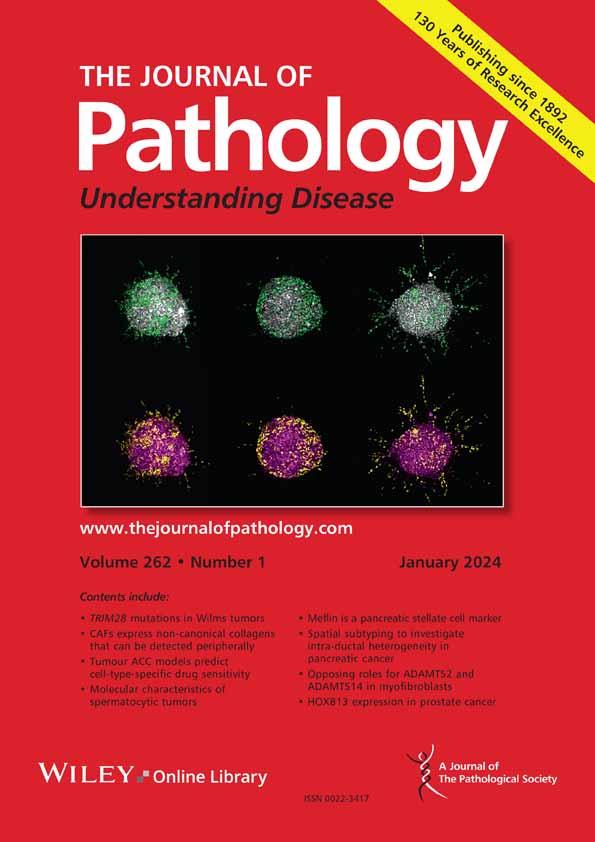Hsiao-Wen Kao, Ming-Chung Kuo, Che-Wei Ou, Ting-Yu Huang, Hung Chang, Tung-Liang Lin, Yu-Shin Hung, Jin-Hou Wu, Lee-Yung Shih
求助PDF
{"title":"慢性髓单细胞白血病进展的克隆动力学:配对样本比较。","authors":"Hsiao-Wen Kao, Ming-Chung Kuo, Che-Wei Ou, Ting-Yu Huang, Hung Chang, Tung-Liang Lin, Yu-Shin Hung, Jin-Hou Wu, Lee-Yung Shih","doi":"10.1002/path.6396","DOIUrl":null,"url":null,"abstract":"<p>This study investigated the clonal evolution of chronic myelomonocytic leukemia (CMML) progression to secondary acute myeloid leukemia (sAML) by next-generation sequencing and pyrosequencing for variant allele frequency (VAF) of gene mutations and SNP microarray for copy neutral loss of heterozygosity (CN-LOH) in 38 paired samples from CMML/sAML patients of Taiwanese origin. The median interval between CMML and sAML samples collection was 14.9 months (1.0–89.6). <i>RUNX1</i> (57%), <i>TET2</i> (46%), <i>SRSF2</i> (37%), and <i>ASXL1</i> (28%) mutations were frequent at CMML diagnosis. Baseline VAF in epigenetic regulator genes was high (>35%) in 83% of mutational events at the CMML phase, remained stable in 78% (VAF changes <10%), and increased in 20% (increased VAF > 10%) during progression to sAML. Transcription factor genes showed high VAF (>35%) in 51% at the CMML phase, and stable VAF in 60% during progression. VAF of spliceosome genes was high (>35%) in 70% at CMML phase, and stable in 61% during progression. Activated signaling genes exhibited acquisition or loss during progression. <i>TET2</i> mutations were often founding clones, and <i>SRSF2</i>, <i>ASXL1</i>, <i>DNMT3A</i>, <i>EZH2</i>, or spliceosome genes also acted as ancestral mutations. <i>RUNX1</i> mutations were typically later events and occasionally ancestral hits or germline mutations. Acquisition of cytogenetic changes, signaling pathways genes (<i>PTPN11</i>, <i>FLT3</i>, <i>NRAS</i>, <i>CBL</i>), or AML-defined genes (<i>NPM1</i>, <i>CEBPA</i>, <i>CBFB</i>::<i>MYH11</i>) by linear or branching evolution occurred during sAML progression. CN-LOH was noted in <i>EZH2</i>, <i>CBL</i>, <i>TET2</i>, and <i>DNMT3A</i> genes. <i>CEBPA</i> mutation and concurrent biallelic <i>TET2</i> with <i>NRAS</i> mutations at CMML diagnosis were risk factors for time to AML progression and overall survival. A characteristic <i>ASXL1</i><sup>MT</sup>/<i>RUNX1</i><sup>MT</sup>/Spliceosome<sup>MT</sup>/signaling<sup>WT</sup> genetic profile was associated with monocyte counts of 0.5–1.0 × 10<sup>9</sup>/l. This study highlights the complexity and heterogeneity of dynamic changes in clonal architecture during CMML progression, emphasizing its importance in pathogenesis, phenotype, risk stratification, and therapeutic strategy. © 2025 The Pathological Society of Great Britain and Ireland.</p>","PeriodicalId":232,"journal":{"name":"The Journal of Pathology","volume":"265 4","pages":"437-447"},"PeriodicalIF":5.2000,"publicationDate":"2025-02-05","publicationTypes":"Journal Article","fieldsOfStudy":null,"isOpenAccess":false,"openAccessPdf":"","citationCount":"0","resultStr":"{\"title\":\"Clonal dynamics of chronic myelomonocytic leukemia progression: paired-sample comparison\",\"authors\":\"Hsiao-Wen Kao, Ming-Chung Kuo, Che-Wei Ou, Ting-Yu Huang, Hung Chang, Tung-Liang Lin, Yu-Shin Hung, Jin-Hou Wu, Lee-Yung Shih\",\"doi\":\"10.1002/path.6396\",\"DOIUrl\":null,\"url\":null,\"abstract\":\"<p>This study investigated the clonal evolution of chronic myelomonocytic leukemia (CMML) progression to secondary acute myeloid leukemia (sAML) by next-generation sequencing and pyrosequencing for variant allele frequency (VAF) of gene mutations and SNP microarray for copy neutral loss of heterozygosity (CN-LOH) in 38 paired samples from CMML/sAML patients of Taiwanese origin. The median interval between CMML and sAML samples collection was 14.9 months (1.0–89.6). <i>RUNX1</i> (57%), <i>TET2</i> (46%), <i>SRSF2</i> (37%), and <i>ASXL1</i> (28%) mutations were frequent at CMML diagnosis. Baseline VAF in epigenetic regulator genes was high (>35%) in 83% of mutational events at the CMML phase, remained stable in 78% (VAF changes <10%), and increased in 20% (increased VAF > 10%) during progression to sAML. Transcription factor genes showed high VAF (>35%) in 51% at the CMML phase, and stable VAF in 60% during progression. VAF of spliceosome genes was high (>35%) in 70% at CMML phase, and stable in 61% during progression. Activated signaling genes exhibited acquisition or loss during progression. <i>TET2</i> mutations were often founding clones, and <i>SRSF2</i>, <i>ASXL1</i>, <i>DNMT3A</i>, <i>EZH2</i>, or spliceosome genes also acted as ancestral mutations. <i>RUNX1</i> mutations were typically later events and occasionally ancestral hits or germline mutations. Acquisition of cytogenetic changes, signaling pathways genes (<i>PTPN11</i>, <i>FLT3</i>, <i>NRAS</i>, <i>CBL</i>), or AML-defined genes (<i>NPM1</i>, <i>CEBPA</i>, <i>CBFB</i>::<i>MYH11</i>) by linear or branching evolution occurred during sAML progression. CN-LOH was noted in <i>EZH2</i>, <i>CBL</i>, <i>TET2</i>, and <i>DNMT3A</i> genes. <i>CEBPA</i> mutation and concurrent biallelic <i>TET2</i> with <i>NRAS</i> mutations at CMML diagnosis were risk factors for time to AML progression and overall survival. A characteristic <i>ASXL1</i><sup>MT</sup>/<i>RUNX1</i><sup>MT</sup>/Spliceosome<sup>MT</sup>/signaling<sup>WT</sup> genetic profile was associated with monocyte counts of 0.5–1.0 × 10<sup>9</sup>/l. This study highlights the complexity and heterogeneity of dynamic changes in clonal architecture during CMML progression, emphasizing its importance in pathogenesis, phenotype, risk stratification, and therapeutic strategy. © 2025 The Pathological Society of Great Britain and Ireland.</p>\",\"PeriodicalId\":232,\"journal\":{\"name\":\"The Journal of Pathology\",\"volume\":\"265 4\",\"pages\":\"437-447\"},\"PeriodicalIF\":5.2000,\"publicationDate\":\"2025-02-05\",\"publicationTypes\":\"Journal Article\",\"fieldsOfStudy\":null,\"isOpenAccess\":false,\"openAccessPdf\":\"\",\"citationCount\":\"0\",\"resultStr\":null,\"platform\":\"Semanticscholar\",\"paperid\":null,\"PeriodicalName\":\"The Journal of Pathology\",\"FirstCategoryId\":\"3\",\"ListUrlMain\":\"https://pathsocjournals.onlinelibrary.wiley.com/doi/10.1002/path.6396\",\"RegionNum\":2,\"RegionCategory\":\"医学\",\"ArticlePicture\":[],\"TitleCN\":null,\"AbstractTextCN\":null,\"PMCID\":null,\"EPubDate\":\"\",\"PubModel\":\"\",\"JCR\":\"Q1\",\"JCRName\":\"ONCOLOGY\",\"Score\":null,\"Total\":0}","platform":"Semanticscholar","paperid":null,"PeriodicalName":"The Journal of Pathology","FirstCategoryId":"3","ListUrlMain":"https://pathsocjournals.onlinelibrary.wiley.com/doi/10.1002/path.6396","RegionNum":2,"RegionCategory":"医学","ArticlePicture":[],"TitleCN":null,"AbstractTextCN":null,"PMCID":null,"EPubDate":"","PubModel":"","JCR":"Q1","JCRName":"ONCOLOGY","Score":null,"Total":0}
引用次数: 0
引用
批量引用






 求助内容:
求助内容: 应助结果提醒方式:
应助结果提醒方式:


